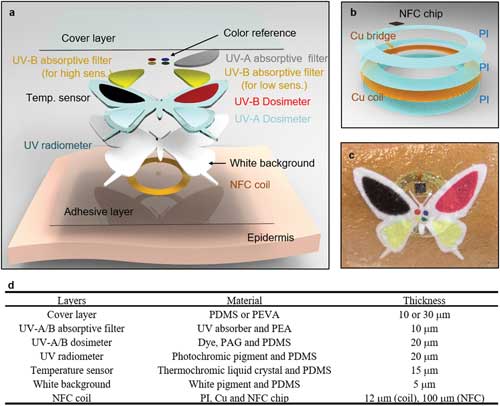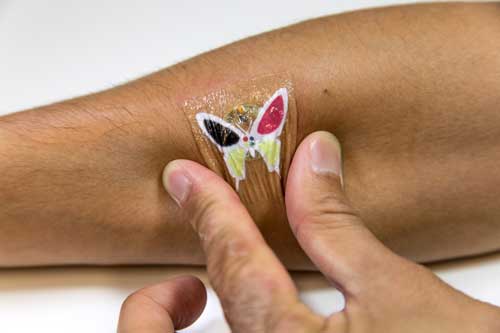| Posted: Nov 23, 2016 | |
Stick-on epidermal electronics tattoo to measure UV exposure (w/video) |
|
| (Nanowerk Spotlight) According to the American Cancer Society, skin cancer is the most common cancer in the United States. In fact, more skin cancers are diagnosed in the US each year than all other cancers combined. The number of skin cancer cases has been going up over the past few decades. | |
| Exposure to ultraviolet (UV) radiation is a major risk factor for most skin cancers. UV rays damage the DNA of skin cells. Skin cancers start when this damage affects the DNA of genes that control skin cell growth. | |
| Sunlight is the major source of UV rays. There are 3 main types of UV rays: | |
|
|
|
| Creating awareness in UV exposure is widely believed to be an important aspect in improving skin health. To take the guesswork out of assessing the exposure to damaging UV rays, several wearable consumer UV sensors have already hit the market. Digital UV sensors – such as the Microsoft Band 2 – provide accurate data, but they mount on wristbands and involve mechanically hard components that are incompatible with the direct application of sunscreen. In addition, their form factors and cost structures prevent use in many activities that are performed in the sun. Commercially available colorimetric sensors also in wristband formats – such as the Intellego Smartsun – circumvent some of these drawbacks, but their degree of accuracy is limited. | |
| In new work coming out of the Rogers Research Group at the University of Illinois at Urbana-Champaign, a skin-like, wearable system combines colorimetric and electronic function for precise dosimetry in the UV-A and UV-B regions of the spectrum. This platform is suitable for determination of instantaneous UV exposure levels and skin temperature. | |
| To demonstrate their platform, the team fabricated a butterfly-shaped epidermal device that exploits four colorimetric sensors and a near field communication (NFC) device. The wireless interface makes it possible to make use of the sensor data in smartphone apps, for instance. | |
 |
|
| Schematic illustrations and digital image of a multimodal, colorimetric epidermal device with capabilities in UV and temperature sensing and in wireless operation via near field communication (NFC) electronics. a) Exploded-view schematic illustration of the various functional layers in a representative system. b) Schematic illustration of the NFC electronics, including an integrated temperature sensor. c) Image of a device on the skin. d) Table of materials and thicknesses for each layer in this system. (Reprinted with permission by Wiley-VCH Verlag) (click on image to enlarge) | |
| "Our goal with this research is to establish a set of foundational materials and device designs for systems that can improve health outcomes by providing information on UV exposure," Prof. John A. Rogers tells Nanowerk. | |
| The researchers in Rogers' group are exploring digital wireless schemes that retain the skin-like embodiment, but provide measurement capabilities that can complement those possible with the colorimetric chemistry approaches reported in a paper in the November 15, 2016 online edition of Advanced Functional Materials ("Materials and Device Designs for an Epidermal UV Colorimetric Dosimeter with Near Field Communication Capabilities"). | |
 |
|
| The epidermal sensor device exhibits a large degree of skin conformability and can be stretched, compressed and pinched. (Image: Philipp Gutruf, University of Illinois at Urbana-Champaign) | |
| "We developed new chemistries that yield color changes that quantitatively relate to total exposure dose, separately in both the UV-A and UV-B regions of the solar spectrum," explains Rogers. "Our formulations have the additional advantage that they provide soft, low modulus mechanics to enhance comfort and biocompatibility with the skin surface." | |
| The only kinds of systems reported in the past for UV dosimetry were either non-quantitative, or non-wearable – or both. This one is the first that adopts a wearable, epidermal type of skin-like construction and, at the same time, provides quantitative information. | |
| A video of the UV colorimetry device during the color change upon UV exposure. (Video: Hitoshi Araki) | |
| This UV sensor is a variation of a novel technology, originally developed in Rogers' lab, called epidermal electronics – ultrathin skin-mounted electronics. In a previous Nanowerk Spotlight we reported on one example of this technology: temperature sensors hat can simultaneously act as micro-heaters. | |
| One of the most attractive aspects of epidermal electronics is that they are disposable. If they can be produced inexpensively, say for $1, then large numbers of people will be able to use them frequently. This could open a new area of health monitoring. | |
 By
Michael
Berger
– Michael is author of three books by the Royal Society of Chemistry:
Nano-Society: Pushing the Boundaries of Technology,
Nanotechnology: The Future is Tiny, and
Nanoengineering: The Skills and Tools Making Technology Invisible
Copyright ©
Nanowerk LLC
By
Michael
Berger
– Michael is author of three books by the Royal Society of Chemistry:
Nano-Society: Pushing the Boundaries of Technology,
Nanotechnology: The Future is Tiny, and
Nanoengineering: The Skills and Tools Making Technology Invisible
Copyright ©
Nanowerk LLC
|
|
|
Become a Spotlight guest author! Join our large and growing group of guest contributors. Have you just published a scientific paper or have other exciting developments to share with the nanotechnology community? Here is how to publish on nanowerk.com. |
|
